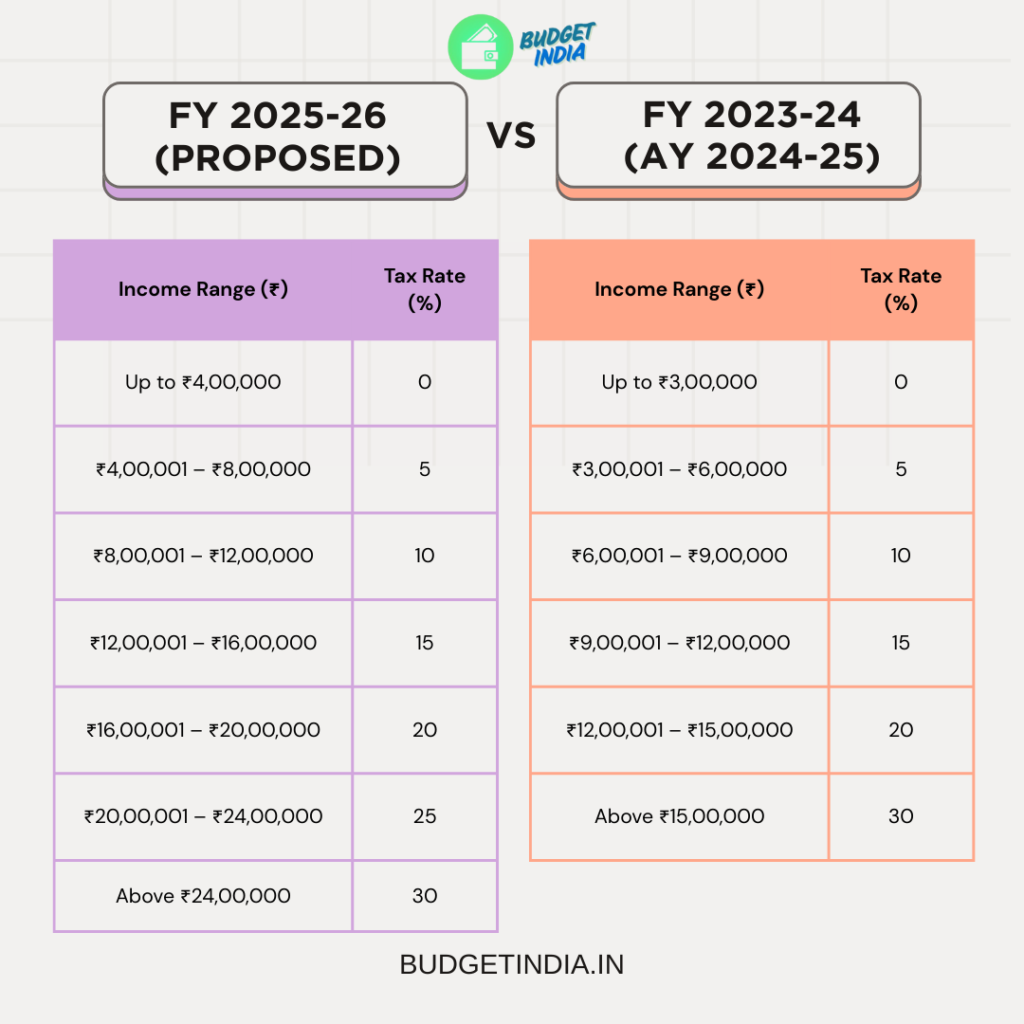Tax season can be confusing, especially with the introduction of the New Tax Regime in India. If you’ve been wondering whether to stick with the old tax regime or switch to the new one, you’re not alone. Many taxpayers are unsure about which option is better for them.
In this article, we’ll break down everything you need to know about the New Tax Regime in India, its benefits, drawbacks, and how to decide if it’s the right choice for you. We’ll also explore the latest updates for FY 2023-24, FY 2024-25, and FY 2025-26 to help you make an informed decision.
Let’s simplify the confusion and help you save more!
What is the New Tax Regime?
The New Tax Regime was introduced in Budget 2020 as an alternative to the existing (old) tax regime. It offers lower tax rates but comes with the condition that you cannot claim most tax deductions and exemptions.
The goal of the New Tax Regime is to simplify the tax filing process and reduce the tax burden for individuals. However, whether it’s beneficial for you depends on your financial situation and the deductions you currently claim.
Latest Updates in the New Tax Regime
The government has made several changes to the New Tax Regime to make it more attractive for taxpayers. Here are the key updates:

1. Increased Basic Exemption Limit
- FY 2023-24: ₹3 lakh
- FY 2024-25: ₹3 lakh
- FY 2025-26: ₹4 lakh (proposed)
2. Higher Rebate Under Section 87A
- FY 2023-24: Tax rebate for incomes up to ₹7 lakh (zero tax).
- FY 2025-26: Proposed tax rebate for incomes up to ₹12 lakh (zero tax).
3. Standard Deduction
- FY 2024-25: Increased to ₹75,000 for salaried individuals and pensioners.
- FY 2025-26: No further changes announced.
4. Revised Tax Slabs for FY 2025-26 (Proposed)
The government has proposed new tax slabs for FY 2025-26 to further reduce the tax burden:
| Income Range (₹) | Tax Rate (%) |
|---|---|
| Up to ₹4,00,000 | 0 |
| ₹4,00,001 – ₹8,00,000 | 5 |
| ₹8,00,001 – ₹12,00,000 | 10 |
| ₹12,00,001 – ₹16,00,000 | 15 |
| ₹16,00,001 – ₹20,00,000 | 20 |
| ₹20,00,001 – ₹24,00,000 | 25 |
| Above ₹24,00,000 | 30 |
Current Tax Slabs Under the New Tax Regime
FY 2024-25 (AY 2025-26)
| Income Range (₹) | Tax Rate (%) |
|---|---|
| Up to ₹3,00,000 | 0 |
| ₹3,00,001 – ₹7,00,000 | 5 |
| ₹7,00,001 – ₹10,00,000 | 10 |
| ₹10,00,001 – ₹12,00,000 | 15 |
| ₹12,00,001 – ₹15,00,000 | 20 |
| Above ₹15,00,000 | 30 |
FY 2023-24 (AY 2024-25)
| Income Range (₹) | Tax Rate (%) |
|---|---|
| Up to ₹3,00,000 | 0 |
| ₹3,00,001 – ₹6,00,000 | 5 |
| ₹6,00,001 – ₹9,00,000 | 10 |
| ₹9,00,001 – ₹12,00,000 | 15 |
| ₹12,00,001 – ₹15,00,000 | 20 |
| Above ₹15,00,000 | 30 |
Key Features of the New Tax Regime
- Lower Tax Rates: The New Tax Regime offers reduced tax rates compared to the old regime.
- No Deductions or Exemptions: You cannot claim popular deductions like Section 80C (up to ₹1.5 lakh), HRA, LTA, or interest on home loans (Section 24).
- Simplified Tax Filing: With fewer deductions to track, the tax filing process becomes simpler.
- Optional: You can choose between the old and new regimes each financial year.
Old Tax Regime vs. New Tax Regime: Which is Better?
To decide which regime is better for you, let’s compare the two:
Old Tax Regime
- Pros:
- Allows you to claim deductions under Section 80C, 80D, HRA, LTA, and more.
- Better for individuals with high investments and expenses eligible for deductions.
- Cons:
- Higher tax rates compared to the new regime.
- Requires detailed documentation and planning.
New Tax Regime
- Pros:
- Lower tax rates for most income brackets.
- Simplified tax filing process.
- Ideal for individuals with minimal investments and deductions.
- Cons:
- No deductions or exemptions, which can increase taxable income.
- May not be beneficial for those with high savings and investments.
Who Should Switch to the New Tax Regime?
The New Tax Regime is a good option if:
- You Don’t Claim Many Deductions: If your investments in tax-saving instruments like PPF, ELSS, or insurance are minimal, the new regime might save you more money.
- You Prefer Simplicity: If you want to avoid the hassle of tracking investments and maintaining receipts, the new regime is easier to manage.
- Your Income is Below ₹7 Lakh: With the rebate under Section 87A, you can effectively pay zero tax under the new regime.
Who Should Stick to the Old Tax Regime?
The Old Tax Regime is better if:
- You Have High Investments: If you’re claiming deductions under Section 80C, 80D, HRA, or home loan interest, the old regime might be more beneficial.
- You Have High Expenses: If you’re paying rent, education loans, or medical insurance premiums, the old regime allows you to reduce your taxable income significantly.
- You’re a Senior Citizen: Senior citizens often have higher medical expenses and investments, making the old regime more advantageous.
How to Decide: Old Regime or New Regime?
Here’s a simple step-by-step approach to help you decide:
- Calculate Your Taxable Income Under Both Regimes:
- Use online tax calculators or consult a CA to compare your tax liability under both regimes.
- List Your Deductions and Exemptions:
- Add up all the deductions you’re eligible for under the old regime (e.g., Section 80C, HRA, LTA).
- Compare the Net Tax Payable:
- If your tax liability is lower under the new regime, consider switching. Otherwise, stick to the old regime.
- Consider Your Financial Goals:
- If you’re planning to invest in tax-saving instruments, the old regime might be more beneficial in the long run.
Common Myths About the New Tax Regime
- Myth: The New Tax Regime is mandatory.
Fact: It’s optional. You can choose between the old and new regimes each year. - Myth: The New Tax Regime is always better.
Fact: It depends on your income, investments, and expenses. - Myth: You can switch back to the old regime anytime.
Fact: Once you choose the new regime for a financial year, you cannot switch back for that year.
FAQs About the New Tax Regime
1. Can I switch between regimes every year?
Yes, you can choose a different regime each financial year based on what’s more beneficial for you.
2. Is the New Tax Regime better for salaried employees?
It depends on your investments and expenses. If you don’t claim many deductions, the new regime might save you more.
3. Can I claim the standard deduction under the New Tax Regime?
Yes, the standard deduction of ₹75,000 is available under both regimes.
Final Thoughts
Choosing between the old and new tax regimes depends on your unique financial situation. While the New Tax Regime offers lower tax rates and simplicity, the Old Tax Regime provides more opportunities to save through deductions and exemptions.
Before making a decision, calculate your tax liability under both regimes and consider your financial goals. If you’re still unsure, consult a Chartered Accountant for personalized advice.
Remember, the goal is to minimize your tax liability while maximizing your savings. So, take your time, evaluate your options, and make the choice that works best for you. Happy tax planning!






Leave a Reply